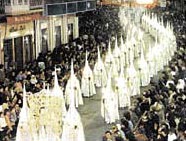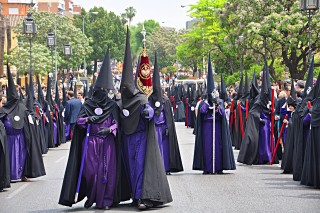Springtime in Seville
 Every time that I get a whiff of the heady fragrance of orange blossom, a scent I love and have never yet taken for granted, I think back with great fondness to the time our family spent in Seville, at the end of March some two years ago. As Easter Sunday that particular year fell on the 27th March the city was actually between its two very diverse festivals, the solemn Easter Holy Week 'Semana Santa', and the very boisterous April Fair, 'Feria de Abril'. During both of these festivals it is virtually impossible to get any kind of accommodation unless you have booked a long time in advance, however between the two the city is quiet as it gathers itself to begin once more the hedonistic lifestyle that is truly Spain, and while they wait there are many Sevillanos who are very happy to tell you what you have missed before by arriving too late and are going to miss in the next week, by leaving too soon!
Every time that I get a whiff of the heady fragrance of orange blossom, a scent I love and have never yet taken for granted, I think back with great fondness to the time our family spent in Seville, at the end of March some two years ago. As Easter Sunday that particular year fell on the 27th March the city was actually between its two very diverse festivals, the solemn Easter Holy Week 'Semana Santa', and the very boisterous April Fair, 'Feria de Abril'. During both of these festivals it is virtually impossible to get any kind of accommodation unless you have booked a long time in advance, however between the two the city is quiet as it gathers itself to begin once more the hedonistic lifestyle that is truly Spain, and while they wait there are many Sevillanos who are very happy to tell you what you have missed before by arriving too late and are going to miss in the next week, by leaving too soon!
Dawn breaks over the sparklingly clean Barrio de Santa Cruz, with its pretty squares and cobbled streets, the fire brigade has done its job well and all lies ready expectantly waiting. By 10.30 the crowds are beginning to form, lining the route to the Cathedral. Some are in their Sunday best, others traditional dress, others even in faded jeans, but nobody cares either way. Throughout this Holy Week, some 57 brotherhoods 'hermandades' will carry 116 cripplingly heavy floats ‘pasos' through the winding streets of Seville to the Cathedral, and back to their churches of origin where they will once more rest until the following year.  The 'hermandades' date back to the thirteenth century when king Fernando III reclaimed the city from the Moors, as they came together to rescue wounded soldiers and bury the dead. They formed according to the trade guilds of the time - blacksmiths, carpenters, masons, sign-makers, etc. and by the sixteenth century, the festival now known as Seville's 'Semana Santa' had been initiated, with Christ's journey to Calvary represented with the processions of the Christs and Virgins of the different guilds.
The 'hermandades' date back to the thirteenth century when king Fernando III reclaimed the city from the Moors, as they came together to rescue wounded soldiers and bury the dead. They formed according to the trade guilds of the time - blacksmiths, carpenters, masons, sign-makers, etc. and by the sixteenth century, the festival now known as Seville's 'Semana Santa' had been initiated, with Christ's journey to Calvary represented with the processions of the Christs and Virgins of the different guilds.
Back in the Barrio de Santa Cruz the procession approaches but first is heard the sound of trumpets, bugles and drums as they mark out a mournful dirge and the first ‘Nazarenes' come into view. Dressed in white tunics with faces covered by midnight blue or black conical hoods they slowly march with candles held in hand. Behind them swaying in time to the music, decked out too in candles, and carrying a very life-like Christ, face covered in blood and wearing the crown of thorns, comes the cripplingly heavy 'Paso' borne by an invisible force of very strong men. Behind this ornate gilded float are the Penitents, dressed in similar attire minus the hats. In days gone by they used to whip themselves, drawing blood, but thankfully times now are less brutal and they carry the cross instead. After these comes the Virgin decked in wonderful velvets and semi precious and precious stones set in a glittering crown. There are tears on her cheeks to denote the pain she feels at the sacrifice of Jesus, as her float comes alongside it pauses and a hush falls over the crowd as one of the women raises her voice and launches into a soulful 'Saeta', a devotional song. As the last chords die away the float moves on. There are many hours to go before it will rest.
During the rest of the day many floats of Christ and The Virgin will pass. However despite the solemnity of the occasion and the genuine devoutness among many, the natural ebullience of the crowd rises and there is much cheering and singing, and obviously tapas and drinking in what will be processions lasting for eight days and seven nights, attracting a million or more visitors who will leave with minds firmly imprinted with the majesty and splendour, the magic and the music that is 'Semana Santa' in Seville.
It seems that the city has hardly organised itself back to work when it is down tools again as another fiesta strikes, this time the April Fair. All of which takes place in a tented ‘city' a mile long and half a mile wide on the other side of the Guadalquivir River. Inside the elaborate gates, for as far as the eye can see are striped 'casetas' or marquees. Aristocratic families, trade unions and political parties host these. The rest of the city is deserted as everyone heads towards the festivities and bars, and restaurants close their doors, the barmen knowing that within those tents they will make as much money during the fiesta week as they would in six months normally.  The immense hard work is all worthwhile under these conditions. There will be time for sleeping once the tents are dismantled.
The immense hard work is all worthwhile under these conditions. There will be time for sleeping once the tents are dismantled.
'La Feria de Abril' is as far removed from Semana Santa as can be imagined, linked only by the Sevillanos love of enjoyment and partying. What started 150 years ago as a cattle trading fair is now a round the clock festival of Flamenco dancing, tapas and drinking. (Where would we be without tapas and drinking?) From late afternoon until dawn, every night for a week the Sevillanos come to the party. Some will come on foot others in cars, buses or on the back of motor bikes; some even in the horse drawn carriages for which Seville is so famous, but come they will. As the city is held in the grip of Flamenco Fever, young girls and women bring out their many-layered traditional dresses complete with elaborate hairpieces in a myriad of colours. For the men too there is the traditional cropped jacket, the tight black trousers and Cuban heels, not forgetting the bolero hat. Even the horses pulling the carriages will be dressed, with their manes plaited with ribbons. As the Spanish love to party, so too do they love to dance. Although the traditional flamenco is usually a solo performance with fast and furious footwork, hand clapping and much flouncing and pregnant pauses, together with the haughty pained looks as the performer acts out the story to the hauntingly beautiful vocal flamenco music; what is normally on offer at the 'Feria' is Sevillana, which is learnt by all school children, particularly in Andalucia. This is a much quieter affair totally. In this dance the steps are simpler, such as the 'Sevillana Paseo' where the partners, male and female, usually mirror each other, turning around each other. Everyone joins in, some later than others after a few 'copas', others immediately; everyone is encouraged, whether they know the steps or not. The heel stamps and toe taps will be in the wrong places, they will not turn the right way, if they turn at all! But who cares? 'Baile, baile' goes the cry. Obviously Sevillana is not the only dancing on offer, so too is the tango, the alegría, the bulería and of course the fandango. All mesh in a whirl of partying, until dawn breaks and with aching feet you struggle home to bed, to sleep, perchance to dream, but almost certainly to get ready for the next night!
This article was kindly contributed by Jo Chambers. Thank you, Jo.
When visiting Sevilla, choose from one of these hotels:
Hotel Alminar
Casa del Maestro
Un Patio en Santa Cruz
Casa Número 7
Casa de Carmona
They are all right in the most interesting old quarter of Seville, except Casa de Carmona which is in a nearby town within easy striking distance of the city.
See another article about Seville here.
30 Jan 2016, 17:47